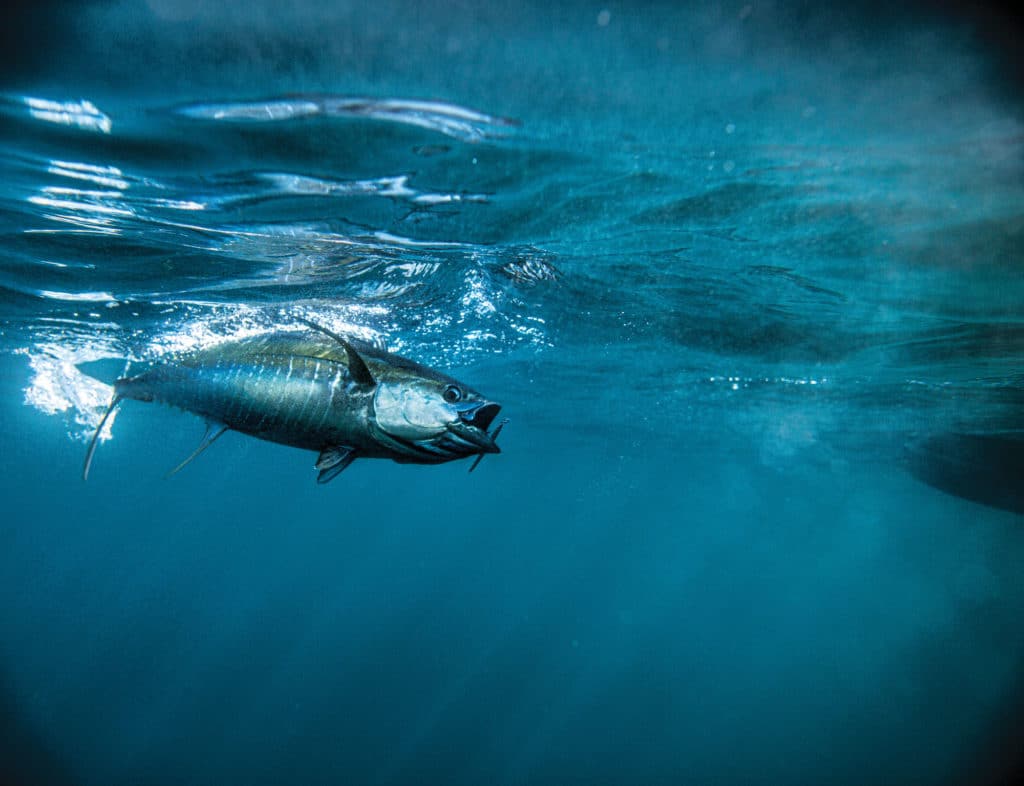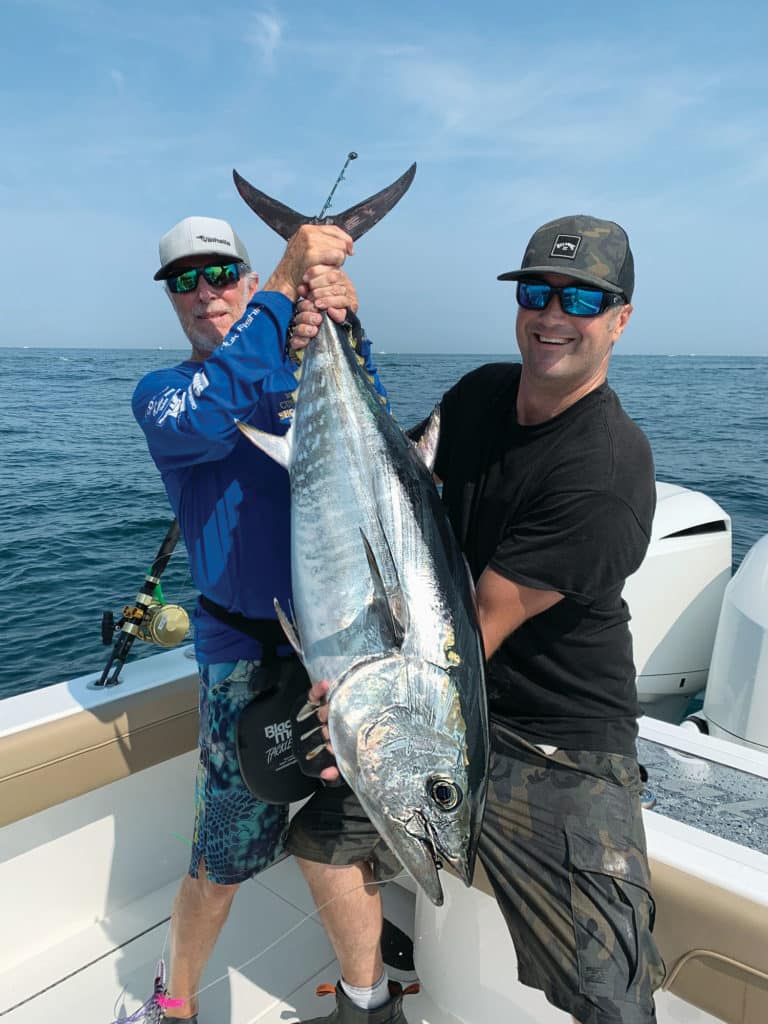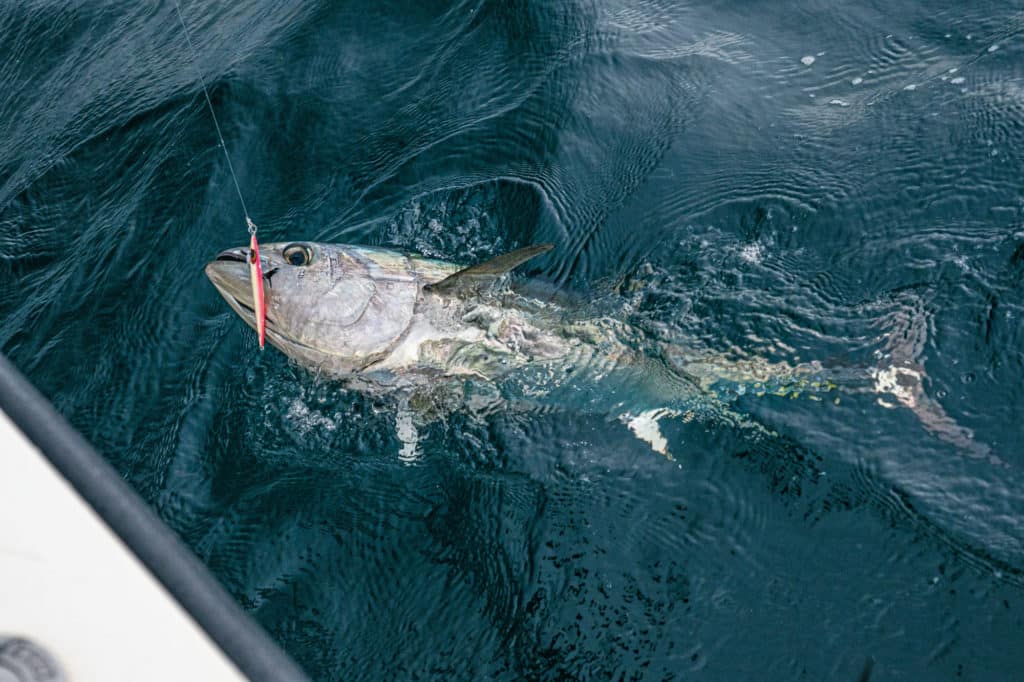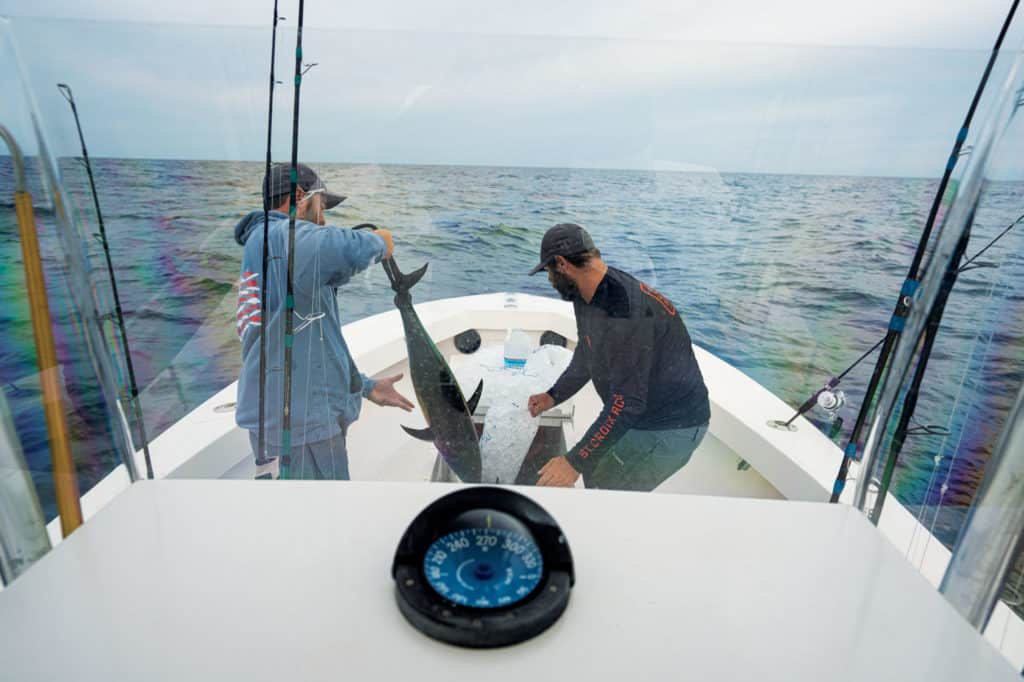
At the Triple Wrecks, 60 miles off the Jersey coast, the bow of Defiance, Capt. Brian Keating’s 36 Valhalla, was pointed toward total mayhem, an area where hundreds of bluefin tuna frantically trashed and splashed while pounding a baitball on the surface. Engines in neutral, the boat drifted toward the madness. I picked a spot on the outskirts of the feeding frenzy to cast a Savage Gear 3D Mack Stick. One, two, three twitches, then bam! The drag on my reel whined as line started ripping off the spool, and the rod arched downward, coming painfully close to its breaking limit. The fight was on.
Three bluefin tuna of 75 to 150 pounds hit the deck in 45 minutes, all hooked on poppers and slide baits, before we swung around for another pass at the school, then another and another, all yielding similar success. The question is, would the results have been even better if we dropped jigs instead of chucking poppers? What determines the right times to throw plugs or drop jigs is a study in tuna feeding habits.
Up Top
Visuals of tuna crashing mackerel schools on the surface gave up the obvious clue to choose a popper. But should poppers always be the first weapon out of your quiver?
Legendary tuna hound Sami Ghandour of Saltywater Tackle offered insights on feeding tuna from North Carolina to Cape Cod.
“Poppers have their place and time. In Cape Cod, they don’t really work, as they push fish down,” Ghandour says. “In New Jersey, however, those fish seem more aggressive and active, and you can get them frustrated easily with a surface popper.”

In Jersey waters, the trend is that tuna usually come up and feed during the afternoon. You might not see the fish coming up, but there are other telltale signs that pinpoint the proper time to toss a popper. “Breaching whales gulping down bait, porpoises corralling a baitball, and the evident V-shaped wakes of tuna schools are all indicators that the fish are ready and willing to feed on top,” Ghandour says. “Conversely, there are times when poppers can be cast randomly to explore and incite tuna down in the water column to come up and investigate.”
A popper with a large, concave face, like the Madd Mantis or Nomad Chug Norris, should be worked with a long draw to spout out substantial spray, then a pause for a second or two before repeating the process. It’s during that brief pause that tuna usually pounce on the popper because it appears that the bait is tired and resting..
Subsurface
“When marking tuna 10 to 30 feet below the surface, or when tuna are pushing water, they are on the move. That’s when I pull out subsurface slide baits and stickbaits,” Ghandour says.
Because bluefin and yellowfin schools move rapidly, you might only have a split second of opportunity to make the perfect cast. “Tuna cruise around subsurface with their eyes facing upward, and that’s when I throw floating stickbaits. The only time I use sinking stickbaits is when birds are picking up the lure and I need to get it down before one snatches it.” Ghandour will cast out a stickbait about 50 yards in front of a moving tuna school and count to 30 or 40 to let the lure sink enough. “For stickbaits, cast, put the rod tip down, keeping a belly in the line. Then twitch it to create a bubble trail behind the lure to trigger a bite. Always twitch to the right, making sure the lure darts under the surface to create a trail of bubbles.”
All Ghandour’s stickbaits are fitted with single inline hooks for a better hookup ratio than treble hooks provide. For Jersey tuna in the 30- to 100-pound range, Ghandour opts for a 4½-inch (120 to 125 mm) lure in a squid color pattern or solid white. When going for larger fish—100- to 200-pounders—in Cape Cod, he steps up to a Tackle House Britt 170 mm pencil in sardine color. And for tuna over 100 inches, Ghandour pulls out the big guns, like the CB One Zorro, Hammerhead Cherry Pai 240, and Rave 220 to 260.
Quick reactions are in order when using stickbaits for tuna. The fish tend to hit when the lure pauses before the next twitch, so be prepared to immediately reel up any slack to set the hook.

Down Low
“Tons of boat traffic lately on the tuna grounds means fish are feeding deeper, and that trend may continue with the growing popularity,” Ghandour says. “Many times, Jersey tuna key on sand eels, so they feed down in the water column. When you mark them deep on the screen, it’s time to drop jigs.” Deep-trolling ballyhoo on planer boards yields strikes from fish you mark in midwater, or even near the bottom, but jigging metals sparks takes from hungry bluefins and yellowfins down deep that bite with conviction.
“That is not speed jigging. I drop down, reel up four to five cranks, then pause. The rod tip should be whipping up and down. Tuck the rod under your arm, lift, and crank once going up. If one guy on the boat hooks up, chances are everyone will get hit on the jig.”
Ghandour believes in CB One F1, G2 and C1 jigs, and fishes them in 80 to 250 grams for 30- to 80-pound-class fish. In Jersey, he prefers 100- to 150-gram versions in red-and-gold or green-and-gold. His jigging rod is an El Maestro 82m 710MH spinning model matched with an 8000-size reel loaded with white, hollow-core Power Pro in 40- to 60-pound-test. That outfit, he claims, serves him well for New Jersey tuna up to 100 pounds.
For Cape Cod or North Carolina bluefins in the 100- to 250-pound range, Ghandour goes heavier, using a Race Point or Monster Ledge 150 or 220ST with a Shimano 14000 Stella spinning reel, or a 300 or 350 model of the same rods matched with a conventional Talica 12 or O’Shea Jigger 4000. His jigging line then is Shimano’s O’Shea EX8 braid in 60- to 80-pound-test.

Factor It In
Many contributing factors go into deciding whether to jig, pop or throw stickbaits for tuna. Learn to read the movements of the schools, and take notice of where the fish hold in the water column and how they interact with the available forage. Adding up all that will point to the right choice of weapon when the tuna come calling.
SWS Tackle Box
Rods: Spinning and conventional 50- to 200-pound models, including Shimano Grappler GRPCS82H, El Maestro 82m 710MH, and Race Point or Monster Ledge 150 to 350, depending on tuna size and location
Reels: Shimano 14000 Stella, Twin Power, Saragosa SG or equivalent for spinning, Shimano Talica 12 or similar option for conventional
Lures: CB One F1, G2 or C1 jigs in 80 to 250 grams, CB One Zorro and Ryan 200 stickbait, Savage Gear 3D Mack Stick, Hammerhead Cherry Pai 200, Nomad Chug Norris 150, and Madd Mantis Popper
SWS PLANNER
What: Bluefin and yellowfin tuna
Where: Massachusetts to North Carolina
When: Year-round
Who: Boating anglers with stout casting and jigging tackle, and the will and stamina to battle some of the strongest fish in the ocean. For specialized gear, visit saltywatertackle.com.









